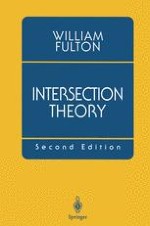1998 | OriginalPaper | Chapter
Rationality
Author : William Fulton
Published in: Intersection Theory
Publisher: Springer New York
Included in: Professional Book Archive
Activate our intelligent search to find suitable subject content or patents.
Select sections of text to find matching patents with Artificial Intelligence. powered by
Select sections of text to find additional relevant content using AI-assisted search. powered by
Refined intersection products can be used to prove the existence of rational solutions of algebraic equations, either in the given ground field K, or in extensions of restricted degrees.Suppose V I ,…, V r , are subvarieties of a complete nonsingular variety X, with codim (Vi, X) = dim (X). By our construction, the intersection cycle V I ,…, V r is represented by a 0-cycle on Therefore there are points P1,…, Pt in and integers n 1 ,…, n r such that $$ \sum\limits_{i = 1} {{n_i}} [K({P_i}):K] = \deg ([{V_1}]{ \cdot _{ \cdot \cdot \cdot }} \cdot [{V_r}]) $$ For example, if and the right side is odd, must contain real points. If some part of the intersection class is known, similar conclusions are valid for the rest of it. Each isolated point P of appears in (*), with coefficient the intersection multiplicity of the V j at P. With suitable positivity assumptions on the tangent bundle of X, the coefficients n i , can all be taken to be non-negative, even when the intersections are improper.Notation. If W is a complete scheme, i.e. W is proper over the ground field K, and α =Σn p [P] is a 0-cycle on W, the degree of a is the sum $$ \deg (\alpha ) = \sum {{n_P}} [K(P):K] $$ where K(P) is the residue field of at P, and [K(P): K] is the degree of the field extension. Rationally equivalent 0-cycles have the same degree (§ 1.4).For example, if is the field of real numbers (or an arbitrary real closed field), then if P is a real point of W, K(P) = if P is complex, and $$ \deg (\alpha ) = \sum\limits_{Preal} {{n_p}} + 2\sum\limits_{Pcomplex} {{n_p}} $$ In particular, if deg (a) is odd, W must contain real points.Let i: X → Y be a regular imbedding of codimension d, V a pure d-dimensional subscheme of Y, W= X∩V. Let N be the restriction of N X Y to W, C = C W V the normal cone to Win V,[C] =Σm i [C i ] its cycle on N. Recall is the largest divisible subgroup of. (Use Examples 13.12 and 1.6.6.)(d) If any two points of can be joined by a chain of rational curves (e.g. if Xc is a unirational variety), then $${{\tilde{A}}_{0}}\left( X \right) = {{\left( {\mathbb{Z}/2\mathbb{Z}} \right)}^{{s - 1}}} $$ Two points of X(R) are rationally equivalent if and only if they belong to the same connected component of X(R). (Use Example 10.1.6.)Using results of M. Knebusch and H. Delfs, Colliot-Thélène and Ischebeck (1) prove analogous results for arbitrary real closed fields.
